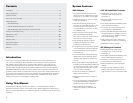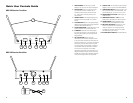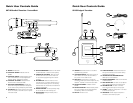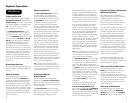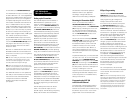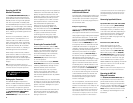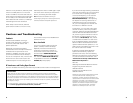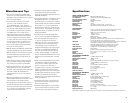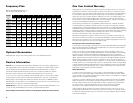
10 11
is controlled by the VOLUME CONTROL (12).
For unbalanced line output connection, plug
an audio cable with a ¼” mono (Tip/Sleeve)
plug into the Unbalanced Line Out jack and
plug the other end into your mixing board
or amplifier. Adjusting the Volume control
will increase or decrease the audio level at
the ¼” Unbalanced Line Out only. When
using the UBT-100 instrument transmitter
system, connect the Unbalanced Line Out
directly to your instrument amp or preamp.
At maximum receiver volume setting, the
system output is approximately +4dB higher
than a direct cord-to-amp connection.
For XLR Balanced Mic Output connection,
plug an audio cable with an XLR connector
into the XLR BALANCED MIC OUT (10) socket
and plug the other end into your mixing
board or amplifier and control the audio
levels from there.
Both the ¼” Unbalanced Line Out and the
XLR Balanced Mic Out can be used at the
same time to connect to your mixing board,
effect, or amplifier.
Note: As when making any connection, make sure
the amplifier or mixing board volume is at the
minimum level before plugging in the receiver
to avoid possible sound system damage.
Note: Only one transmitter can be used with one
receiver. It is not possible to use two transmitters
on the same frequency and mix the output of
these transmitters into one wireless receiver.
Your UWS-100 receiver is now operational
and ready to use. Proceed to the following
instructions for the UHT-100 handheld
microphone transmitter or UBT-100
bodypack transmitter included with
your system.
UHT-100 Handheld
Microphone Transmitter
Setting up the Transmitter
The UHT-100 requires two AA alkaline or
NiMH batteries to operate (do not mix
types). To install the batteries, press at the
“Open” end of the BATTERY COVER (23) and
slide down per the arrow indicator, exposing
the BATTERY COMPARTMENT (19). Insert two
fresh AA batteries according to the polarity
indicated on the transmitter body. Slide the
battery cover back onto the microphone,
making sure it is secure. Fresh alkaline
batteries can provide up to 8-10 hours of
operation, but in order to ensure optimal
performance it is recommended that the
batteries be replaced after 6-8 hours of use
or as indicated necessary by the flashing
BATT ICON (16B). The transmitter has a built-in
INTERNAL ANTENNA (22). For best operating
range, do not handle this antenna during use.
The UHT-100 handheld transmitter has two
small switches under the battery cover;
the TRANSMITTER LOCK SWITCH (20) and the
RF HI/LO POWER SWITCH (21). To access these
two switches, slide down and remove the
cover. These switches have ON and OFF
positions and function as follows:
When the transmitter lock switch is in the
OFF position, the KEY ICON (16C) does not
appear on the LCD DISPLAY (16). To prevent
the possibility of accidentally turning off
the transmitter during use, switch it to the
ON position. The key icon will appear on the
LCD display and the transmitter OFF/STBY/
ON switch will be disabled. The standby and
IR channel programming will still function
normally.
The RF HI/LO power switch can be set
either in HI (more RF output) or in LO
(less RF output). The LO setting will prolong
battery life and is also recommended for
simultaneous multichannel operation.
Select the level for your application
accordingly. A range walk test will
determine if the LO setting is adequate.
Powering the Transmitter On/Off
To turn on the transmitter, slide the
OFF/STBY/ON POWER SWITCH (18) to the
middle standby position. The LCD BACKLIGHT
(16) will light up, indicating the unit is now
on. After five seconds the backlight will
automatically turn off to conserve battery
life. The LCD DISPLAY (16) indicator icons
stay on for normal operation.
As many of the five LCD display BATTERY
LEVEL BARS (16B) should stay lit as possible,
indicating usable battery strength. As
the batteries weaken, fewer of the level
indicators will stay lit until only one bar
shows, which will then flash “BATT” to
warn that the batteries are now too low
and should be replaced as soon as possible
with fresh ones.
To preserve battery life, turn the transmitter
off when not in use. To turn the transmitter
off, check that the TRANSMITTER LOCK
SWITCH (20) is in OFF position with the KEY
ICON (16C) not showing on the LCD DISPLAY
(16). Then slide the power On/Off switch to
the OFF position. The LCD or backlight are
not lit up, indicating the unit is off.
At power off the transmitter will store the
last settings entered and re-display them
at the next power on. The default factory
setting is Channel 14.
Programming the UHT-100
to the Selected Channel
The transmitter must be programmed to
the same frequency as selected for the
receiver via automatic synchronization using
the IR ASC
™
Sync function. It can not be
programmed on the transmitter itself.
IR Sync Programming
Use the wireless IR RECEPTOR SENSOR
WINDOW (17) infrared LED to download
pre-programmed channels from the receiver.
Start programming by holding the IR
receptor sensor/window about 6-12”
from the front of the receiver, then press
the ASC SYNC BUTTON (7) briefly on the
receiver. The red LED inside the receiver’s
IR WINDOW (6) will flash twice quickly
within two seconds. This LED indicates IR
transmission is in progress. If necessary, the
ASC transfer can be repeated by pressing
the ASC Sync button again. When the
synchronization is completed successfully,
either the RF A OR B LED (5) on the receiver
will light up. Upon successful data transfer
(usually in less than two seconds) the
transmitter’s backlight will light up and the
transmitter will transmit a radio signal on the
same channel as the receiver. The diversity
RF A/B LED indicator on the receiver will
then light up, indicating that the IR linking
is completed. The LCD DISPLAY (16) will
show the matching channel as receiver.
If no action is taken during the two seconds
of active IR data transfer, the receiver and
the transmitter units do not link and the
transmitter’s previous program channel
remains unchanged.
For normal operation, the transmitter
should have the same channel as displayed
on the receiver. The transmitter is now
ready for use.
Note: The IR link is infrared light and thus works
best when this data transfer is accomplished in a
light-shielded or darker environment. It may not
be successful in a brightly lit area. If the transfer
fails, repeat the procedure in a darker location
or somehow shield the link from outside light to
successfully program the transmitter with the
pre-programmed group and channel info from
the receiver.




